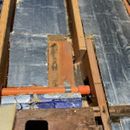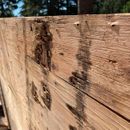Zone 6 unvented cathedral ceiling with sprinklers and can lights. Pictures.
Looking at a Zone 6 roof with some damaged sheathing in spots. Some of this could have come from above, some from below. Your thoughts on the next step are welcome.
* Zone 6 – snow depths up to 30 feet
* Shingle roof going on
* Existing roof is 2×6 sleepers with cut and cobble ISO insulation from 20+ years ago. Detailing is poor.
* Sprinkler heads and can lights.
* From out to in it was shingles, peel & stick, densdeck, tar paper, ply, two layers iso foam, tar paper with penetration holes, 3/4″ tounge and groove. The densdeck was wet and the nails rusty. The decking mixed with a discolored areas. The building was lightly occupied for the entire time, with no humidifier in use.
There’s no existing authorization to remove any sheeting other than what’s rotted. I’d sure like to replace that top layer of ISO foam with something that has better cold weather performance, but not in the cards right now.
The building’s energy cost are about $30,000 in gas per winter season.
GBA Detail Library
A collection of one thousand construction details organized by climate and house part













Replies
"I’d sure like to replace that top layer of ISO foam with something that has better cold weather performance"
Even when it is 0 degrees Fahrenheit outside polyiso, on average according to this below BSC article, is expected to perform at 5.25 R-value per inch. What other "cold weather" rigid insulation do you have in mind that can beat this? Also keep in mind not all the layers of the polyiso are experiencing the same temperature differential, the outer most one takes the brunt of the thermal performance reduction.
https://buildingscience.com/sites/default/files/migrate/pdf/BSCInfo_502r_Temperature_Dependence_R-Values.pdf
How thick is the foam? And what sort of building is it? $30,000 in annual gas bills? Without knowing whether it's a house or a Wal-Mart, its hard to suggest a fix.
Looks like you are approaching this from above, is that correct? If so, how about:
1. Seal from above at all the cut & cobble with all the gaps. That will reduce air leaks and interior humidity from migrating to the roof deck/roof plywood
2. Use caulk to seal around the fire sprinkler and can light penetrations
3. Determine what caused the rot - it looks like dry rot or insect damage. Was there an actual leak?